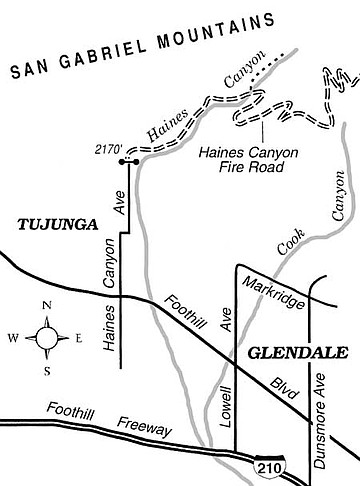 Facebook
Facebook
 X
X
 Instagram
Instagram
 TikTok
TikTok
 Youtube
Youtube
Coyotes howl, water splashes down a willow-lined creek, and hummingbirds flit about in search of nectar. All of this takes place barely a mile from the grid of suburban streets on the fringe of Los Angeles. We're talking about Haines Canyon in the foothill community of Tujunga, but it's a lot like dozens of other small canyon streams that give up their water to the concrete storm channels of the city below. At the mouth of almost every one of these steep canyons yawns a debris basin, often 50 to 100 feet wide, designed to catch the slurry of silt, sand, rocks, and boulders that roars down the mountain slopes during infrequent cloudbursts.
A fire road ascends Haines Canyon and continues all the way to 5074-foot Mt. Lukens, on the crest of the front range of the San Gabriel Mountains. The modest goal on this hike, though, is merely to reach a secluded middle section of Haines Canyon, almost totally removed from the sight and the sounds of the city.
To get to Haines Canyon, first find Foothill Boulevard, which strings together the communities of Glendale, Tujunga, and Sunland. Turn north on Haines Canyon Avenue in Tujunga and drive to its dead end. Find a place to park and then walk past two vehicle gates, passing a typical, stark-looking debris basin and dam. Continue on the dirt road that runs up along the Haines Canyon creek. You'll pass 12 check dams (also called crib dams) down along the creek, all constructed of the same kind of precast concrete pieces that look like gray Lincoln logs. The regrowth of native trees such as willows, live oaks, and sycamores in the canyon bottom has done a lot to soften the impact of these erosion-resistant structures.
After 1.2 miles, the road curves abruptly right and climbs out of the canyon toward Mt. Lukens, which lies several miles by foot or bike away, and is some 2000 feet higher in elevation. That strenuous effort can be done on a cool, clear day, but our route goes up an obscure, old roadbed to the left -- a sketchy trail now -- going up the main branch of Haines Canyon. Remnants of the old road end beneath a large live oak 1.7 miles from the start. A seasonal stream trickles by. You can picnic at this secluded spot, or press on to explore one source of the water, a spring a couple hundred yards upstream (watch out for poison oak through here, though).
This article contains information about a publicly owned recreation or wilderness area. Trails and pathways are not necessarily marked. Conditions can change rapidly. Hikers should be properly equipped and have safety and navigational skills. The Reader and Jerry Schad assume no responsibility for any adverse experience.


Coyotes howl, water splashes down a willow-lined creek, and hummingbirds flit about in search of nectar. All of this takes place barely a mile from the grid of suburban streets on the fringe of Los Angeles. We're talking about Haines Canyon in the foothill community of Tujunga, but it's a lot like dozens of other small canyon streams that give up their water to the concrete storm channels of the city below. At the mouth of almost every one of these steep canyons yawns a debris basin, often 50 to 100 feet wide, designed to catch the slurry of silt, sand, rocks, and boulders that roars down the mountain slopes during infrequent cloudbursts.
A fire road ascends Haines Canyon and continues all the way to 5074-foot Mt. Lukens, on the crest of the front range of the San Gabriel Mountains. The modest goal on this hike, though, is merely to reach a secluded middle section of Haines Canyon, almost totally removed from the sight and the sounds of the city.
To get to Haines Canyon, first find Foothill Boulevard, which strings together the communities of Glendale, Tujunga, and Sunland. Turn north on Haines Canyon Avenue in Tujunga and drive to its dead end. Find a place to park and then walk past two vehicle gates, passing a typical, stark-looking debris basin and dam. Continue on the dirt road that runs up along the Haines Canyon creek. You'll pass 12 check dams (also called crib dams) down along the creek, all constructed of the same kind of precast concrete pieces that look like gray Lincoln logs. The regrowth of native trees such as willows, live oaks, and sycamores in the canyon bottom has done a lot to soften the impact of these erosion-resistant structures.
After 1.2 miles, the road curves abruptly right and climbs out of the canyon toward Mt. Lukens, which lies several miles by foot or bike away, and is some 2000 feet higher in elevation. That strenuous effort can be done on a cool, clear day, but our route goes up an obscure, old roadbed to the left -- a sketchy trail now -- going up the main branch of Haines Canyon. Remnants of the old road end beneath a large live oak 1.7 miles from the start. A seasonal stream trickles by. You can picnic at this secluded spot, or press on to explore one source of the water, a spring a couple hundred yards upstream (watch out for poison oak through here, though).
This article contains information about a publicly owned recreation or wilderness area. Trails and pathways are not necessarily marked. Conditions can change rapidly. Hikers should be properly equipped and have safety and navigational skills. The Reader and Jerry Schad assume no responsibility for any adverse experience.
